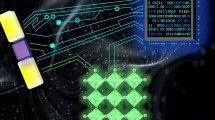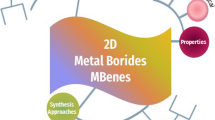Abstract
Zero-dimensional (0D) metal halides are in a blossoming status for their fascinating optoelectronic properties. Herein, an antimony-based metal halide of (C16H28N)2SbCl5 (C16H28N+ = benzyltripropylammonium cations), where the isolated [SbCl5]2− clusters are surrounded by C16H28N+ to form a 0D square-pyramidal structure, was synthesized and investigated. The (C16H28N)2SbCl5 exhibited a broadband orange emission at 633 nm upon the low-energy irradiation (400 nm) with a near-unity photoluminescence quantum efficiency (97.8%). Interestingly, (C16H28N)2SbCl5 showed an additional emission peak at 477 nm upon the higher-energy irradiation (300 nm), which is attributed to the transformation of the doublet of spin-orbit couplings into two independent self-trapped excitons (STEs). Temperature-dependent Raman spectra clearly revealed the characteristics of multi-phonon coupling, demonstrating a strong anharmonic electron-phonon interaction in (C16H28N)2SbCl5. Temperature-dependent emission spectra and density functional theory results illustrated that the observed dual-band emission originated from singlet and triplet STEs in [SbCl5]2− units. Combined with the efficient emission and excellent stability of (C16H28N)2SbCl5, a stable white-light-emitting diode with an ultra-high color rendering index of 96.6 was fabricated.

摘要
零维金属卤化物因其迷人的光电特性而处于蓬勃发展的状态. 本文报道了一种(C16H28N)2SbCl5(C16H28N+ = 苄基三丙基铵阳离子)的锑基金属卤化物, 其中孤立的[SbCl5]2−团簇被C16H28N+包围, 形成零维方形金字塔结构. (C16H28N)2SbCl5在低能辐照(400 nm)时在633 nm处呈现宽带橙色发射, 具有97.8%的近单位光致发光量子效率. 有趣的是,(C16H28N)2SbCl5在高能辐照(300 nm)时在477 nm处显示出一个额外的发射峰, 这是由自旋-轨道耦合的二重态转变为两个独立的自束缚激子形成的. 变温拉曼光谱显示了多声子耦合的特征, 这证明(C16H28N)2SbCl5中存在强烈的非谐性电子-声子相互作用. 变温发射光谱和密度泛函理论计算表明, 所观察到的双峰发射源于[SbCl5]2−单元中的单重态和三重态自束缚激子. 结合(C16H28N)2SbCl5的高效发光和优异的稳定性, 我们还制备了超高显色指数为96.6的稳定白光发光二极管.
Similar content being viewed by others
References
Fang Y, Zhai S, Chu L, et al. Advances in halide perovskite memristor from lead-based to lead-free materials. ACS Appl Mater Interfaces, 2021, 13: 17141–17157
Yang X, Ma LF, Yan D. Facile synthesis of 1D organic-inorganic perovskite micro-belts with high water stability for sensing and photonic applications. Chem Sci, 2019, 10: 4567–4572
Wang H, Luo Q, Sun ML, et al. Perovskite nanogels: Synthesis, properties, and applications. J Mater Chem C, 2020, 8: 12355–12379
Qi Z, Chen Y, Guo Y, et al. Highly efficient self-trapped exciton emission in a one-dimensional face-shared hybrid lead bromide. Chem Commun, 2021, 57: 2495–2498
Peng H, Wang X, Tian Y, et al. Highly efficient cool-white photoluminescence of (Gua)3Cu2I5 single crystals: Formation and optical properties. ACS Appl Mater Interfaces, 2021, 13: 13443–13451
Peng H, Tian Y, Wang X, et al. Large-scale facile-synthesis and bistable emissions of one-dimensional organic-inorganic C4H14N2PbBr4 metal halide crystals with bipolaronic states. New J Chem, 2021, 45: 17247–17257
Yang W, Xiao X, Li M, et al. Conjugated ditertiary ammonium templated (100)-oriented 2D perovskite with efficient broad-band emission. Chem Mater, 2021, 33: 4456–4464
Spanopoulos I, Hadar I, Ke W, et al. Water-stable 1D hybrid tin(II) iodide emits broad light with 36% photoluminescence quantum efficiency. J Am Chem Soc, 2020, 142: 9028–9038
Peng H, Wang X, Zhang Z, et al. Bulk assembly of a 0D organic tin(II) chloride hybrid with high anti-water stability. Chem Commun, 2021, 57: 8162–8165
Peng H, Wang X, Tian Y, et al. Water-stable zero-dimensional (C4H9)4NCuCl2 single crystal with highly efficient broadband green emission. J Phys Chem Lett, 2021, 12: 6639–6647
Peng H, Huang T, Zou B, et al. Organic-inorganic hybrid manganese bromine single crystal with dual-band photoluminescence from polaronic and bipolaronic excitons. Nano Energy, 2021, 87: 106166
Zhou L, Liao JF, Kuang DB. An overview for zero-dimensional broadband emissive metal-halide single crystals. Adv Opt Mater, 2021, 9: 2100544
McCall KM, Morad V, Benin BM, et al. Efficient lone-pair-driven luminescence: Structure-property relationships in emissive 5s2 metal halides. ACS Mater Lett, 2020, 2: 1218–1232
Morad V, Shynkarenko Y, Yakunin S, et al. Disphenoidal zero-dimensional lead, tin, and germanium halides: Highly emissive singlet and triplet self-trapped excitons and X-ray scintillation. J Am Chem Soc, 2019, 141: 9764–9768
Wang Z, Zhang Z, Tao L, et al. Hybrid chloroantimonates(III): Thermally induced triple-mode reversible luminescent switching and laser-printable rewritable luminescent paper. Angew Chem Int Ed, 2019, 58: 9974–9978
Lin F, Wang H, Liu W, et al. Zero-dimensional ionic antimony halide inorganic-organic hybrid with strong greenish yellow emission. J Mater Chem C, 2020, 8: 7300–7303
Zhao JQ, Han MF, Zhao XJ, et al. Structural dimensionality modulation toward enhanced photoluminescence efficiencies of hybrid lead-free antimony halides. Adv Opt Mater, 2021, 9: 2100556
Peng H, Tian Y, Wang X, et al. Bulk assembly of a 0D organic antimony chloride hybrid with highly efficient orange dual emission by self-trapped states. J Mater Chem C, 2021, 9: 12184–12190
Zhou C, Worku M, Neu J, et al. Facile preparation of light emitting organic metal halide crystals with near-unity quantum efficiency. Chem Mater, 2018, 30: 2374–2378
Li Z, Li Y, Liang P, et al. Dual-band luminescent lead-free antimony chloride halides with near-unity photoluminescence quantum efficiency. Chem Mater, 2019, 31: 9363–9371
Wei Q, Chang T, Zeng R, et al. Self-trapped exciton emission in a zero-dimensional (TMA)2SbCl5·DMF single crystal and molecular dynamics simulation of structural stability. J Phys Chem Lett, 2021, 12: 7091–7099
Tan Z, Chu Y, Chen J, et al. Lead-free perovskite variant solid solutions Cs2Sn1−xTexCl6: Bright luminescence and high anti-water stability. Adv Mater, 2020, 32: 2002443
Jing Y, Liu Y, Zhao J, et al. Sb3+ doping-induced triplet self-trapped excitons emission in lead-free Cs2SnCl6 nanocrystals. J Phys Chem Lett, 2019, 10: 7439–7444
Peng H, Tian Y, Zhang Z, et al. Bulk assembly of zero-dimensional organic copper bromide hybrid with bright self-trapped exciton emission and high antiwater stability. J Phys Chem C, 2021, 125: 20014–20021
Wei JH, Luo JB, Liao JF, et al. Te4+-doped Cs2InCl5·H2O single crystals for remote optical thermometry. Sci China Mater, 2022, 65: 764–772
Wu Y, Han D, Chakoumakos BC, et al. Zero-dimensional Cs4EuX6 (X = Br, I) all-inorganic perovskite single crystals for gamma-ray spectroscopy. J Mater Chem C, 2018, 6: 6647–6655
Su B, Song G, Molokeev MS, et al. Synthesis, crystal structure and green luminescence in zero-dimensional tin halide (C8H14N2)2SnBr6. Inorg Chem, 2020, 59: 9962–9968
Yang B, Yin L, Niu G, et al. Lead-free halide Rb2CuBr3 as sensitive X-ray scintillator. Adv Mater, 2019, 31: 1904711
Zou B, Hou L, Tian Y, et al. Anomalous nonlinear optical effect and enhanced emission by magnetic excitons in CVD grown cobalt-doped ZnSe nanoribbon. New J Phys, 2021, 23: 033019
Zou M, Wang J, Khan MS, et al. Spin-related optical behaviors of dilute magnetic semiconductor ZnSe:Ni(II) nanobelts. Nanotechnology, 2020, 31: 325002
Zou S, Yang G, Yang T, et al. Template-free synthesis of high-yield Fe-doped cesium lead halide perovskite ultralong microwires with enhanced two-photon absorption. J Phys Chem Lett, 2018, 9: 4878–4885
Peng H, Yao S, Guo Y, et al. Highly efficient self-trapped exciton emission of a (MA)4Cu2Br6 single crystal. J Phys Chem Lett, 2020, 11: 4703–4710
Li M, Xia Z. Recent progress of zero-dimensional luminescent metal halides. Chem Soc Rev, 2021, 50: 2626–2662
Jing Y, Liu Y, Jiang X, et al. Sb3+ dopant and halogen substitution triggered highly efficient and tunable emission in lead-free metal halide single crystals. Chem Mater, 2020, 32: 5327–5334
Zhao Z, Zhong M, Zhou W, et al. Simultaneous triplet exciton-phonon and exciton-photon photoluminescence in the individual weak confinement CsPbBr3 micro/nanowires. J Phys Chem C, 2019, 123: 25349–25358
Fontana M, Maisano G, Migliardo P, et al. Raman scattering and melting point in SbCl3. Optica Acta-Int J Opt, 1980, 27: 1087–1093
Emin D. Optical properties of large and small polarons and bipolarons. Phys Rev B, 1993, 48: 13691–13702
Zhang ZZ, Jin JC, Gong LK, et al. Co-luminescence in a zero-dimensional organic-inorganic hybrid antimony halide with multiple coordination units. Dalton Trans, 2021, 50: 3586–3592
Jing Y, Liu Y, Li M, et al. Photoluminescence of singlet/triplet self-trapped excitons in Sb3+-based metal halides. Adv Opt Mater, 2021, 9: 2002213
Biswas A, Bakthavatsalam R, Mali BP, et al. The metal halide structure and the extent of distortion control the photo-physical properties of luminescent zero dimensional organic-antimony(III) halide hybrids. J Mater Chem C, 2021, 9: 348–358
Xiong G, Yuan L, Jin Y, et al. Aliovalent doping and surface grafting enable efficient and stable lead-free blue-emitting perovskite derivative. Adv Opt Mater, 2020, 8: 2000779
Wang A, Guo Y, Zhou Z, et al. Aqueous acid-based synthesis of lead-free tin halide perovskites with near-unity photoluminescence quantum efficiency. Chem Sci, 2019, 10: 4573–4579
Acknowledgements
This work was financially supported by Guangxi National Science Foundation project (2020GXNSFDA238004) and the Bagui Scholar Project of Guangxi Province.
Author information
Authors and Affiliations
Contributions
Author contributions Peng H, Wang J, and Zou B designed and carried out the experiments. Peng H and Tian Y performed the material preparation and analyzed the data. Yu Z and Ke B measured the temperature-dependent emission spectra. Wang X performed the theoretical calculation. Zhao Y and Dong T helped to fabricate the LED device. All authors participated in discussing the data and writing the manuscript
Corresponding authors
Ethics declarations
Conflict of interest The authors declare that they have no conflict of interest.
Additional information
Supplementary information Supporting data are available in the online version of the paper.
Hui Peng received his MS degree from Zhengzhou University, Zhengzhou, China, and currently he is studying for his PhD degree at Beijing Institute of Technology, China. His research focuses on crystal growth, crystal structure analysis, and luminescent properties of the low-dimensional metal halide materials.
Jianping Wang is a professor of chemistry at the Institute of Chemistry, Chinese Academy of Sciences. His main research interests include ultrafast visible-infrared spectroscopy and ultrafast multidimensional spectroscopy and their applications in chemistry, physics, biophysics, and material sciences. He currently serves as a member of the Editorial Advisory Board of Journal of Physical Chemistry.
Bingsuo Zou received his BS degree from Jilin University in 1985 and obtained his PhD degree from Jilin University in 1991. He joined Guangxi University, Guangxi, China, in 2019, as a professor. His research focuses on optoelectronic materials, nanophotonics, and optics of magnetic semiconductors.
Rights and permissions
About this article
Cite this article
Peng, H., Tian, Y., Yu, Z. et al. (C16H28N)2SbCl5: A new lead-free zero-dimensional metal-halide hybrid with bright orange emission. Sci. China Mater. 65, 1594–1600 (2022). https://doi.org/10.1007/s40843-021-1937-y
Received:
Accepted:
Published:
Issue Date:
DOI: https://doi.org/10.1007/s40843-021-1937-y




